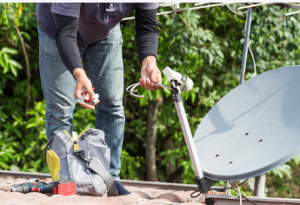If you’re ready to mount your TV antenna, make sure you know of any obstacles. Then, determine whether a signal amplifier is required. If you can’t see the signal, you might want to mount a standalone mast from the soffit instead. Mounting window-mounted antennas require some specific considerations. They’re mounted above the roofline and point away from the house.
 Mounting a TV antenna
Mounting a TV antenna
There are many factors to consider when mounting your TV antenna. The most important thing is the height of the antenna, as this will determine the signal level you get. The antenna should be mounted about 10 to 20 feet above ground level to receive the best signal. Avoid placing the antenna too high in a location where it will block the light of other nearby structures. Additionally, mounting the antenna on a metal roof should be done at least one meter off the ground.
If you have a tall tree in your backyard, you may be able to mount your TV antenna there. However, choose a tree with no large obstructions or other things that could interfere with the signal. Taller trees will give the best signal strength. If you have no experience climbing trees, you may want to hire someone to install your TV antenna. In this case, you will need to use a mounting kit that comes with screws. Again, consult the professional antenna installer for more information.
Once you have bought the coaxial cable, you will need some tools. A few of these tools are essential for installation. First, you need coaxial cable compression fittings, which are metal fittings that fit into device connectors. Next, coax wire tools will help you connect the cable to the television antenna. You can also use a compass to ensure that the direction of the antenna is facing the transmission tower. Finally, if you don’t have a level, you can use a carpenter’s level to ensure that the mast is perfectly vertical.
Checking for obstructions
While installing a TV antenna, check for obstructions that could be blocking the antenna signal. It will prevent you from receiving the signal. In addition to avoiding obstructions, ensure the location of the antenna is free of obstructions. For example, certain channels may have transmission towers at lower elevations or behind other buildings. It can prevent line-of-sight problems. If your television is more than 70 miles from the broadcast towers, you might need a preamplifier to receive a clear signal. Consult the professional antenna installer for more information.
A TV signal meter can be useful in checking for obstacles. Professionals use TV signal meters, while amateurs can purchase inexpensive devices. Ensure that you have the necessary parts and tools before beginning your installation. It’s also helpful to check the alignment of the antenna. To ensure that the antenna is perfectly aligned, you can use a signal meter. It’s essential to match the polarisation of the elements and the signal.
While it’s not as important with an indoor antenna, avoiding obstructions is essential to get a clear picture. For example, a TV signal can be bounced when interrupted by obstacles like walls or other buildings. Also, if the antenna is installed too high, it may not receive as clear a signal as it should. To prevent bounced signals, move the antenna close to a window.
Using a signal amplifier
Using a signal amplifier is an excellent way to boost weak signals, such as those that are weakened due to grounding blocks, splitters, or physical obstructions. This device can help overcome these challenges and help you get the best picture possible from your TV antenna. Here are some of the advantages of using a signal amplifier:
First, amplifiers improve reception quality. However, they introduce noise into the TV line. Unless you’re using a signal amplifier in conjunction with a high-gain antenna, it’s best to get an antenna that already has a good signal. It’s important to note that some signal amplifiers can improve reception while others deteriorate. If you’re not sure, you should always hire a professional installer to help you.
Signal amplifiers can be divided into masthead amplifiers and distribution amplifiers. The masthead amplifier is smaller and installed on the mast. A distribution amplifier can be installed inside the roof, cupboard, or service duct. The latter type is used in homes with multiple TV wall points and weak signals. While the names of these products are not directly comparable, they’re both useful in TV antenna installation.
